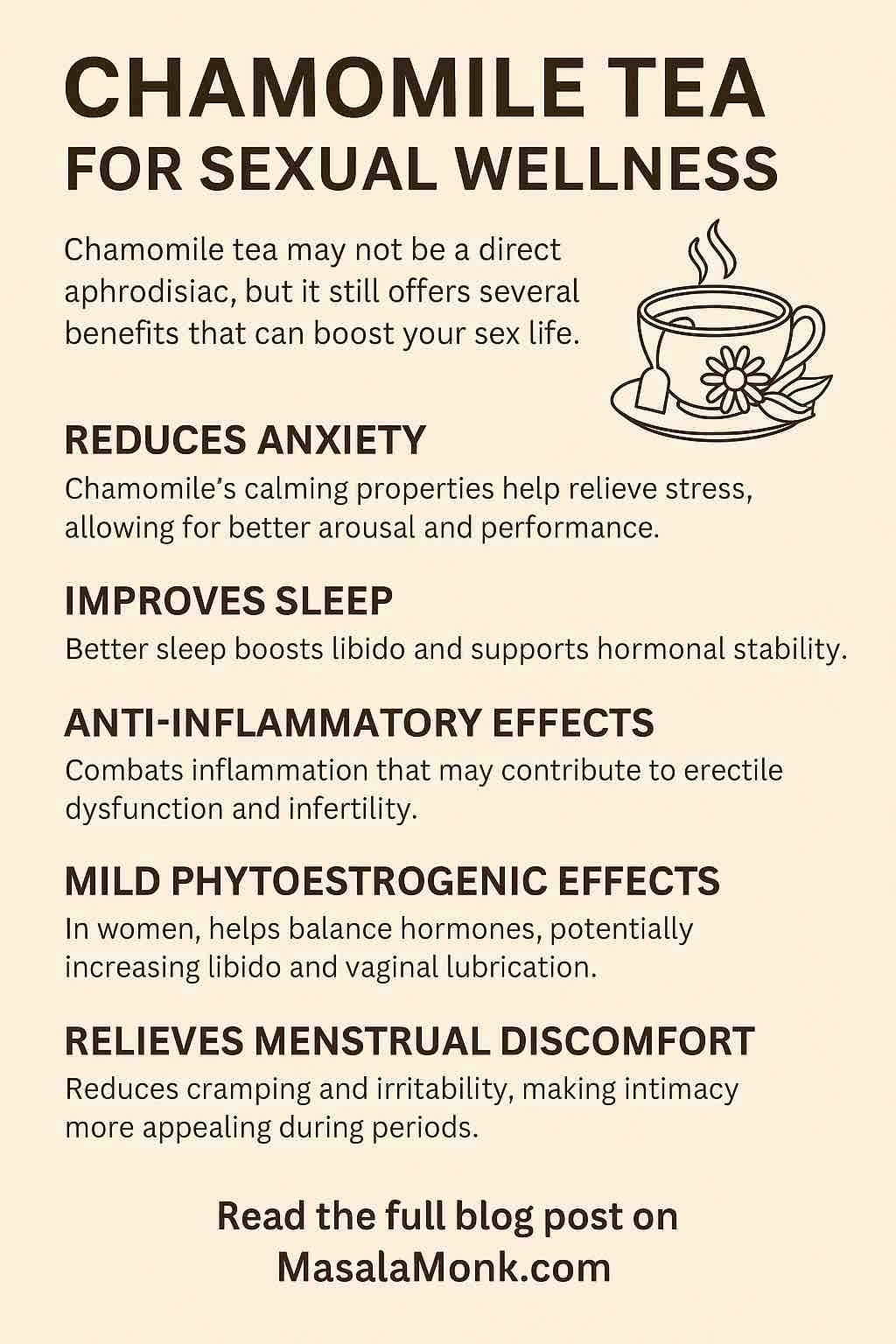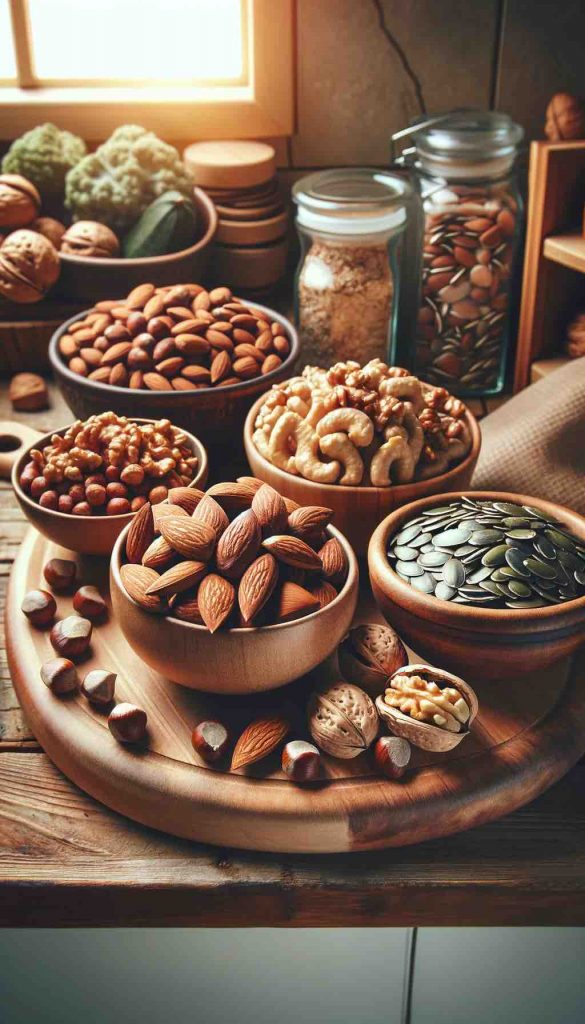
When most people think of chamomile tea, the first image that comes to mind is a steaming cup beside a cozy bed, aiding in relaxation and restful sleep. But this humble flower has a far more intriguing range of effects than just calming the nerves. Recent research is shining a light on chamomile’s potential impact on sexual health, especially for women, and the findings are as fascinating as they are promising.
The Traditional Use of Chamomile: More Than Just a Sleep Aid
Chamomile (Matricaria chamomilla L.) has been used for centuries in herbal medicine to treat digestive issues, inflammation, and stress. Its rich composition includes flavonoids like apigenin, essential oils, and other bioactive compounds. These ingredients have been associated with anxiolytic (anxiety-reducing), anti-inflammatory, antioxidant, and even mild estrogenic effects.
Traditionally used as a natural sedative, chamomile tea has found its place in modern wellness circles for its sleep-inducing and stress-relieving properties. However, the same attributes that promote calmness and physical well-being may also subtly influence sexual function.
The Science: Chamomile and Sexual Function in Women
1. Clinical Trials and Postmenopausal Women
One of the most compelling studies in recent years was a 2022 double-blind, randomized controlled trial that examined the effects of chamomile vaginal gel on postmenopausal women. The study found significant improvement across all six domains of female sexual function:
- Desire
- Arousal
- Lubrication
- Orgasm
- Satisfaction
- Pain reduction
Compared to a placebo group, those using chamomile gel experienced markedly better outcomes. These results are comparable to those seen with hormone-based treatments like conjugated estrogen cream, but with a more natural profile and fewer side effects.
2. Dyspareunia and Pain Relief
Another study focused on women suffering from dyspareunia (painful intercourse), a common complaint during and after menopause due to vaginal dryness and thinning tissues. Chamomile gel application was associated with both increased sexual satisfaction and reduced pain levels.
3. Phytoestrogenic Effects
Chamomile contains phytoestrogens, plant-based compounds that mimic estrogen in the body. These can be particularly helpful for women undergoing hormonal changes, providing mild support for libido, vaginal lubrication, and overall sexual satisfaction. While tea may not be as concentrated as a vaginal gel, regular consumption could still offer a low-dose benefit over time.
Indirect Benefits: The Mind-Body Connection
Sexual health is a complex interplay of physiological, psychological, and emotional factors. Chamomile tea doesn’t just act on the reproductive system—it influences the entire mind-body connection, which is essential for a fulfilling sex life.
1. Reducing Anxiety and Enhancing Mood
Anxiety is one of the most common psychological barriers to sexual performance and enjoyment. Chamomile tea’s calming effect—thanks to apigenin binding to benzodiazepine receptors in the brain—helps reduce stress and promote a sense of ease, which can directly impact libido and arousal.
2. Improving Sleep Quality
Sleep is fundamental to hormone regulation. Testosterone and estrogen production occur primarily during deep sleep phases. Regular chamomile consumption can improve sleep quality, thus indirectly boosting hormonal balance and, by extension, sexual health.
3. Anti-Inflammatory and Antioxidant Support
Oxidative stress and chronic inflammation are increasingly being recognized as underlying factors in erectile dysfunction and female arousal disorders. Chamomile’s rich antioxidant profile may help mitigate these effects, supporting better vascular function and sensitivity.
Men’s Sexual Health: Any Benefits?
While most of the recent clinical research has centered on women, men may also reap subtle benefits from chamomile:
- Stress and performance anxiety relief
- Improved sleep and testosterone regulation
- Enhanced vascular health through anti-inflammatory action
While not a direct aphrodisiac like ginseng or maca, chamomile supports the foundational health metrics that underpin male sexual wellness.
How to Incorporate Chamomile Into Your Routine
- Tea: Steep 1–2 teaspoons of dried chamomile flowers in hot water for 5–10 minutes. Drink 1–2 cups daily.
- Vaginal Gel: For targeted relief, chamomile-based gels are now commercially available and may be worth discussing with a healthcare provider.
- Essential Oils: Use diluted chamomile oil in aromatherapy to promote relaxation before intimacy.
🔹 Summary of Potential Benefits to Sexual Health
| Benefit | How It Helps Sexually |
|---|---|
| Reduced anxiety | Better arousal and performance |
| Better sleep | Higher testosterone and hormonal stability |
| Anti-inflammatory effects | Improves blood flow, reduces ED risk |
| Mild estrogenic effects | Helps with libido and lubrication (especially in women) |
| PMS relief | Less discomfort = more openness to intimacy |
Caveats and Considerations
- Allergic Reactions: Those allergic to plants in the daisy family should avoid chamomile.
- Medication Interactions: Chamomile can interact with blood thinners, sedatives, and hormone therapies.
- Dosage: Stick to moderate consumption. Overuse may lead to nausea or dizziness in sensitive individuals.
Final Thoughts: A Gentle Ally in Sexual Wellness
Chamomile may not be a miracle herb, but it offers a gentle, accessible, and natural support system for sexual health—particularly for women navigating hormonal changes. With growing scientific interest and consumer options expanding, chamomile is steadily earning its place not just in the kitchen, but in the broader conversation about intimacy and well-being.
Whether you’re sipping a calming cup before bed or exploring new ways to reconnect with your partner, chamomile stands as a symbol of how the smallest natural ingredients can have meaningful impacts on our most personal aspects of health.
🔍 Frequently Asked Questions (FAQs)
1. Can chamomile tea directly increase libido?
Chamomile tea doesn’t act as a direct aphrodisiac, but by reducing anxiety, promoting better sleep, and potentially supporting hormonal balance, it may help improve libido indirectly.
2. Is chamomile tea effective for men’s sexual health?
Yes, to a degree. While research is limited, chamomile’s stress-reducing and anti-inflammatory effects may support testosterone levels, erectile function, and overall mood, all of which are relevant to male sexual health.
3. How often should I drink chamomile tea to notice benefits?
Drinking 1–2 cups per day consistently over several weeks is generally recommended to experience its calming and wellness-promoting effects.
4. Are there specific studies supporting chamomile’s impact on sexual function?
Yes. A 2022 clinical trial found chamomile vaginal gel significantly improved all areas of sexual function in postmenopausal women. While tea is less concentrated, the findings suggest potential benefits worth exploring.
5. Can I use chamomile tea as a replacement for hormone therapy?
No. Chamomile may provide mild phytoestrogenic support, but it is not a substitute for medical-grade hormone therapy. Always consult a healthcare provider before making changes to your treatment plan.
6. Is it safe to use chamomile vaginal gel?
Yes, studies have shown chamomile vaginal gel to be safe and effective for many women, but individual sensitivities vary. A patch test and consultation with a gynecologist are recommended before long-term use.
7. Can chamomile cause allergic reactions?
Yes. People allergic to ragweed, daisies, marigolds, or chrysanthemums should avoid chamomile, as it can trigger allergic reactions.
8. Are there any drug interactions I should be aware of?
Chamomile can interact with blood thinners, sedatives, and hormone therapies. If you’re on any medications, check with your doctor before consuming chamomile regularly.
9. How does chamomile support better sleep and why is that important sexually?
Chamomile contains apigenin, which binds to brain receptors that induce sleep. Good sleep boosts testosterone and other hormones essential for a healthy sex drive and function.
10. What’s the best way to include chamomile in a sexual wellness routine?
Combine daily tea drinking with aromatherapy (using chamomile essential oil) for relaxation. Women may also explore chamomile vaginal gels for localized support after consulting with a medical professional.














